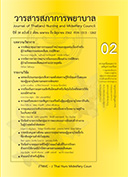Nursing Management in Transitional Care Model: A Case Study of Patients with Peripheral Arterial Disease
Keywords:
nursing management, transitional care, case study, patient with peripheral arterial diseaseAbstract
Peripheral arterial disease, a common circulatory disorder characterised by arterial atresia, can be caused by a number of factors, such as atherosclerosis and polycythemia. This disease impedes blood circulation to peripheral organs, causing necrosis and risk of amputation.
This article presents a case study of patients with peripheral arterial disease caused by polycythemia during the critical stage of their chronic illnesses. Due to their complications, the patients were treated using a specially managed nursing care model closely supervised by advanced practice nurses. Customised to suit individual patients’ needs, this caregiving model integrated various competencies to provide transitional
care for the patients, from their admission, transfer, critical stage, long-term rehabilitation, to palliative care.
Subjected to thorough problem evaluation and conducted based on empirical evidence, this model was expected to be capable of inducing changes, multidisciplinary collaboration, ethical decision-making and family empowerment. These factors could improve the entire caregiving process and produce desirable outcomes, enabling patients and their families to cope with the illness-induced changes, adjust to their fnal
stage and be ready to pass away peacefully.
Downloads
References
The Thai Society of Hematology; 2015 [cited 2019 Feb 10]. Available from: http://tsh.or.th/Knowledge/
Details/40 (in Thai).
2. Aronow WS. Peripheral arterial disease of the lower extremities. Arch Med Sci 2012; 8: 375-88. doi: 10.5114/aoms.2012.28568. PubMed PMID:22662015.
3. Hardman RL, Jazaeri O, Yi J, Smith M, Gupta R.Overview of classifcation systems in peripheral artery disease. Semin Intervent Radiol. 2014; 31: 378-88.doi: 10.1055/s-0034-1393976. PubMed PMID: 25435665.
4. Abdulhannan P, Russell DA, Homer-Vanniasinkam S. Peripheral arterial disease: a literature review, Br Med Bull, 2012;104: 21–39. doi: 10.1093/bmb/lds027. PubMed PMID: PMID: 23080419.
5. Pechar J, Lyons MM. Acute compartment syndrome of the lower leg: a review. J Nurse Pract. 2016;12:265-70. doi: 10.1016/j.nurpra.2015.10.013.PubMed PMID: 27499719.
6. Vasaroangrong T. Peripheral arterial occlusive disease:roles of nurses in screening. Journal of Nursing Science & Health. 2014;37(4):132-38. (in Thai).
7. Panchoowong T, Utriyaprasit K, Kimpee S,Satayawiwat W. Ischemic Leg Pain Experienced, Management Strategies, and Outcomes in Patients with Peripheral Arterial Occlusion Disease. Thai Journal of Nursing Council. 2008; 23(1) 60-73. (in Thai).
8. Sumneangsanor T. Coping with Loss and Grief. Journal of Science and Technology. 2013; (21Suppl 7): S 658-67. (in Thai).
9. Kinlay S. Management of critical limb ischemia. Circ Cardiovasc Interv. 2016;9:e001946. doi:10. 1161/circinterventions.115.001946. PubMed PMID: PMID: 26858079.
10. Meleis AI. Transition theory: middle - range and situation specifc theories in nursing research and practice
[internet]. New York : Springer Publishing; 2010 [cited 2018 June 21]. Available from: https:// taskurun.fles.wordpress.com/2011/10/transitions_theory__middle_range_and_situation_specifc_theories_in_nursing_research_and_practice.pdf.
11. Phoodaangau B. Transition Theory: Its Application to Family Nursing Care. Thai Journal of Nursing Council 2013; 28(3):107-20. (in Thai).
12. Wanchai A, Chaisa P, Srinon R. Nursing care of patients with amputation. Chiangrai Medical Journal.
2560; 9(2):139-46. (in Thai).
13. Saengmanee S, Arpanantikul M, Sirapo-ngam Y. A case study: Adaptation of a Working Caregiver to a Stroke Patient. Ramathibodi Nursing Journal. 2012;18(1):119-25. (in Thai).
14. Kasemkitwattana S, Prison P. Chronic patients’ family caregivers: A risk group that must not be overlooked. Thai Journal of Nursing Council.2014;29(4):22-31. (in Thai).
15. Nongthong T, Kachondham P, Quality of Life of Severely Physical Disabled. Journal of Social Development 2017;19(2):113-31. (in Thai).
16. Wongprach B. Phantom Syndrome: Overlooked Problem. Journal of the Royal Thai Army Nurses 2014;15(2):117-22. (in Thai).
17. Subedi B, Grossberg GT. Phantom limb pain: mechanisms and treatment approaches. Pain Res Treat. 2011;1-18.doi: 10.1155/2011/864605. PubMed PMID: 22110933.
18. Medscape Pharmacists. Amitriptyline/Perphenazine.[Internet]. New York: WebMD;c1994-2009 [cited 2019 Feb 12]. Available from: https://reference.medscape.com/drug/etrafon-triptafenamitriptyline-perphenazine-342946
19. Kim SY, Kim YY. Mirror therapy for phantom limb pain. Korean J Pain. 2012;25:272-74. doi:10.3344/kjp.2012.25.4.272. PubMed PMID:23091690.
20. Sirirak P, Dajpratham P, Thanakiatpinyo T. The Effectiveness of Mirror Therapy in Chronic Stroke Patients with Plegic Hand: a Pilot Study. Journal of Thai Rehabilitation Medicine. 2013;23(1):29-36. (in Thai).
21. Soowit B, Panasakulkan S. Muksiritipanun B. The assessment of the suffering symptoms in palliative care patient. Songklanagarind Journal of Nursing. 2015;35(1):153-64. (in Thai).
22. Jiewprasat K. Nursing roles and support in end-of-life decision making for critically ill patients : a case study.
Thai Journal of Cardio-Thoracic Nursing. 2015;26(2):15-24. (In Thai).
23. Suandok Palliative Care. Palliative Performance Score (PPS). [internet]. Chiangmai : Maharajnakorn
Chiangmai Hospital; 2015 [cited 2019 Feb 12].Available from: http://www.med.cmu.ac.th/spc/
index.php/pps. (In Thai).








